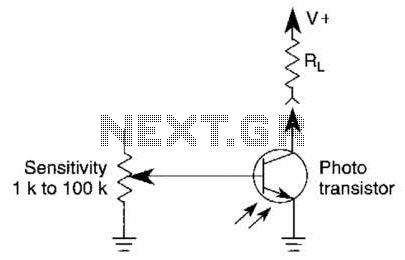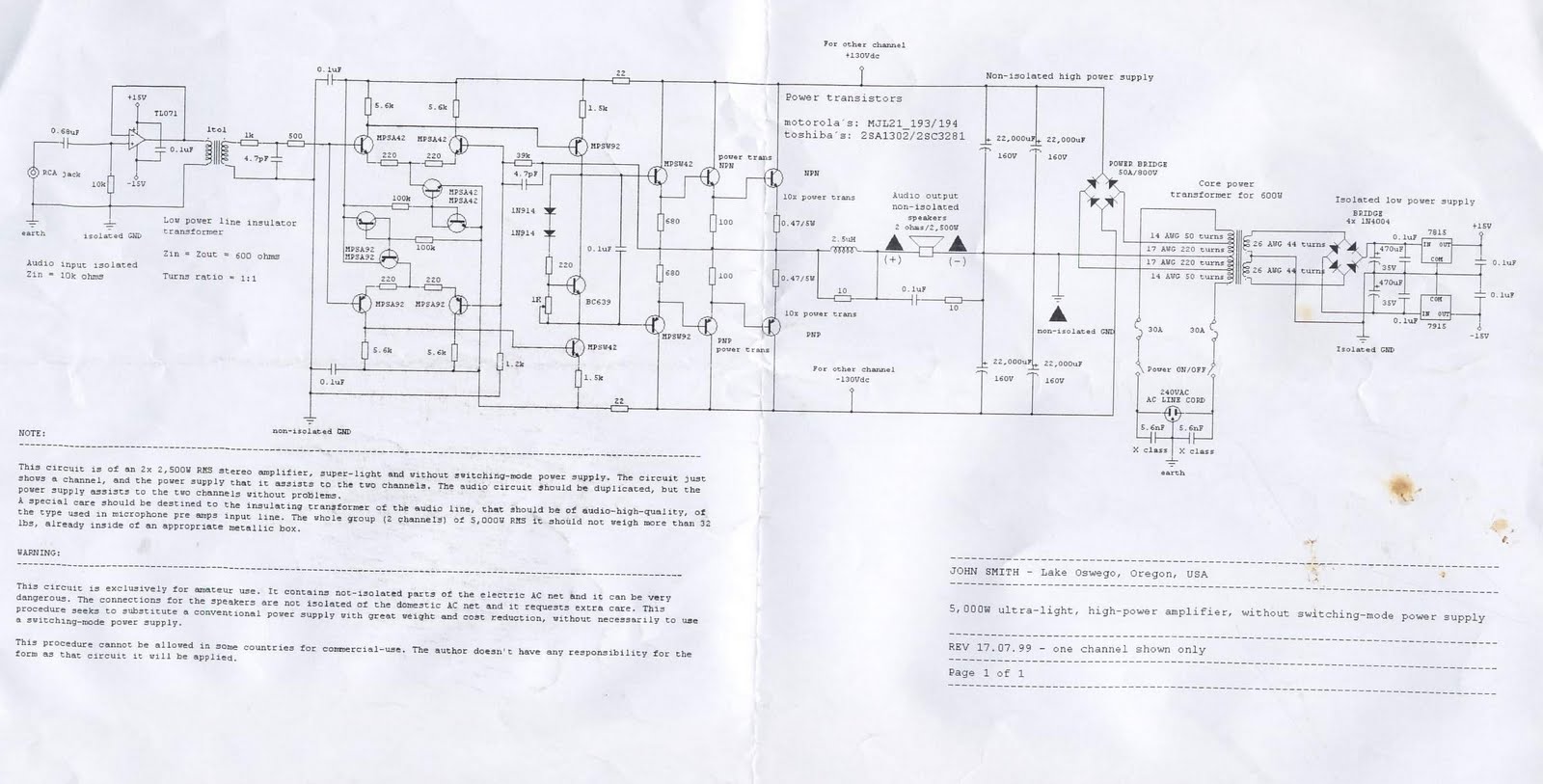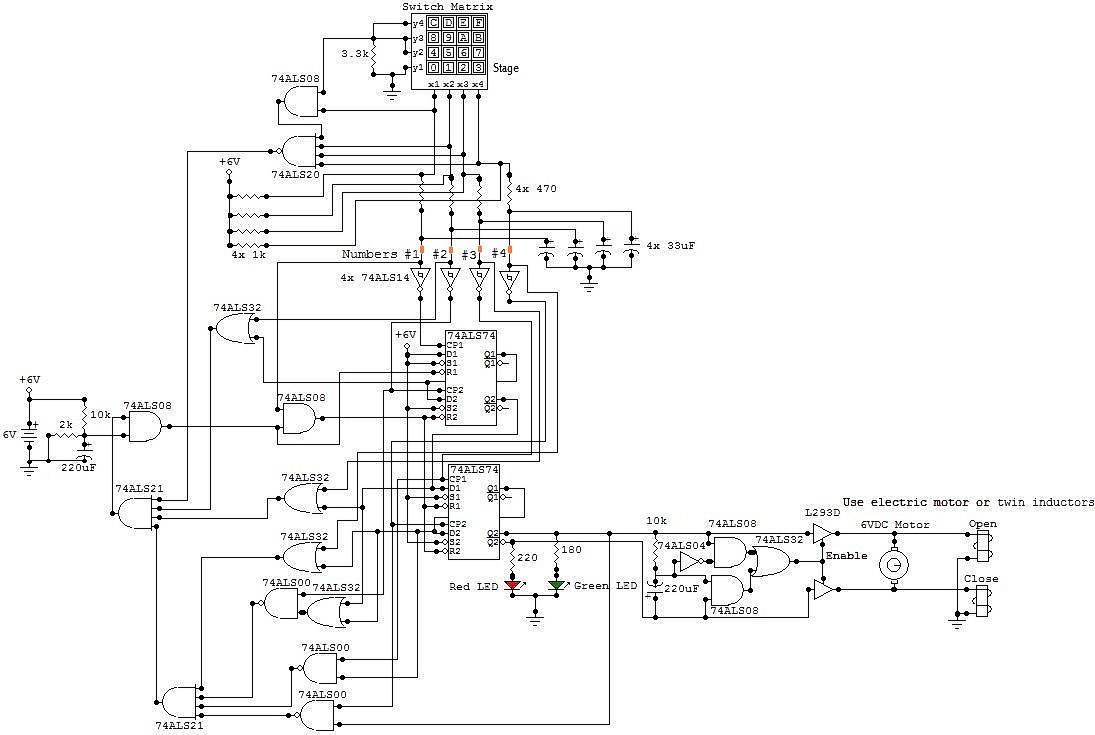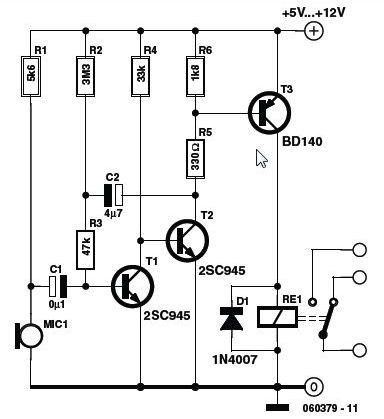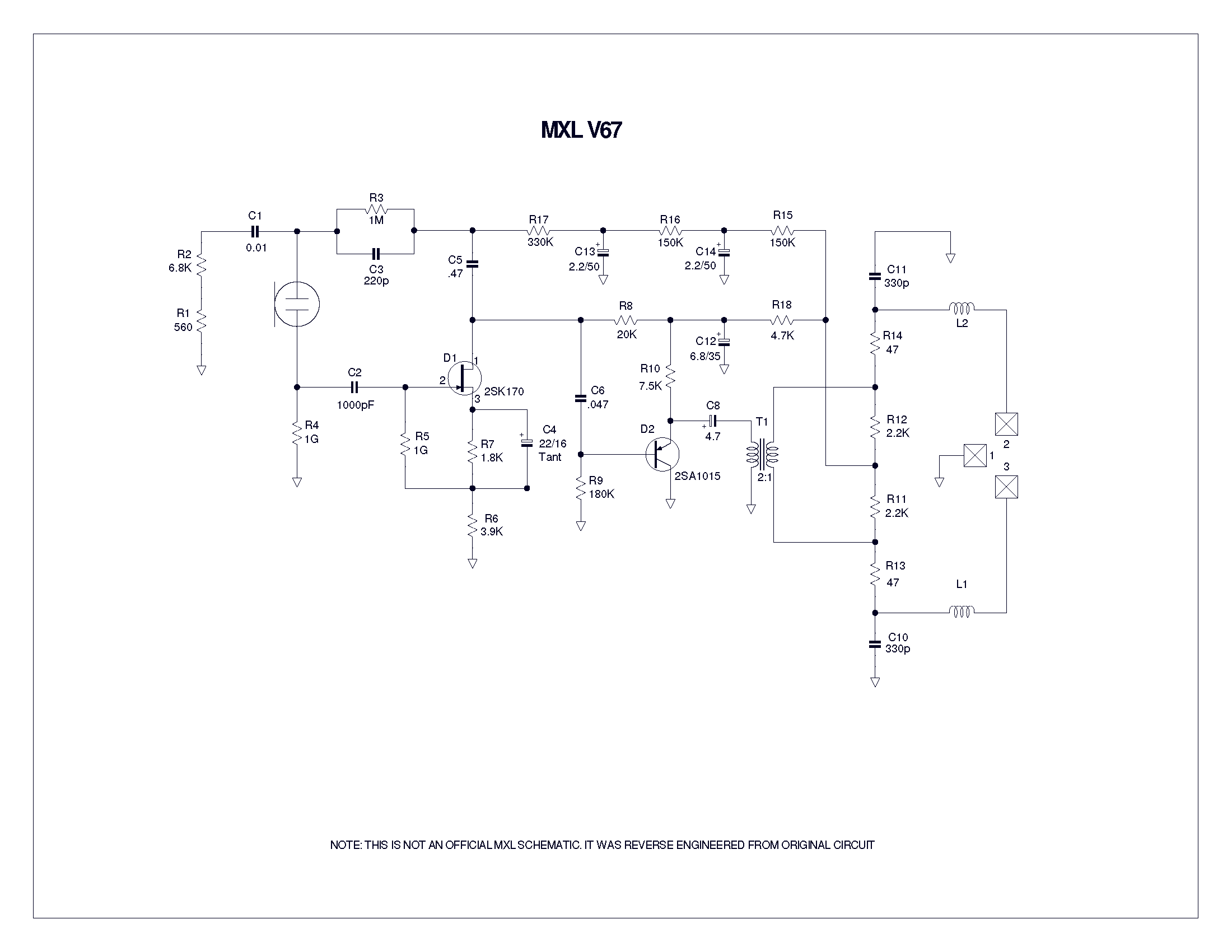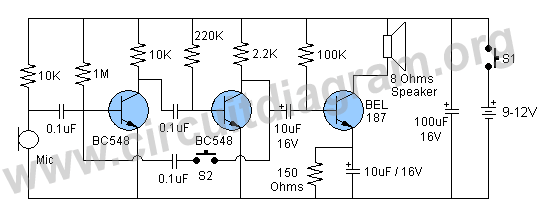
electronic doorbell circuit

This design outlines a door alarm circuit that utilizes an electronic system. It features a synthesized sound chip from Holtek, specifically the HT-2811, which reproduces the sound of a "ding-dong" chiming doorbell. The circuit also incorporates a CMOS 4026 counter display driver IC to keep track of visitors. The operating voltage must remain within 2.4 to 3.3 VDC, and the standby current is minimal. A reset switch is included to zero the count, and the 7-segment display is of the common cathode type. To conserve power consumption, the display can be toggled on or off with a switch, while the count remains stored in memory. The chime envelope is determined by the 220k, 330k, 3.3µF, and 4.7µF resistors and capacitors, which are set to the manufacturer's default values but can be adjusted to modify the duration and delay of the chime. Additionally, a resistor-capacitor network consisting of 2.2k, 22k, and 47µF serves a dual purpose: it provides a debouncing circuit for the bell press and ensures that rapid presses of the doorbell switch only increment the count once. The 47µF capacitor may be increased in size if necessary.
This door alarm circuit is designed for simplicity and efficiency, making it suitable for various applications in residential or commercial settings. The HT-2811 sound chip is capable of producing high-quality audio output, ensuring that the chime is both pleasant and attention-grabbing. The CMOS 4026 driver IC is crucial for displaying the visitor count, allowing for easy monitoring of foot traffic.
Operating within a voltage range of 2.4 to 3.3 VDC ensures compatibility with a wide array of power sources, including batteries and low-voltage power supplies. The minimal standby current is an essential feature for battery-operated applications, extending the overall lifespan of the device.
The inclusion of a reset switch facilitates quick resetting of the visitor count, making it user-friendly. The common cathode 7-segment display provides clear visibility of the count, while the ability to enable or disable the display with a switch allows for further power savings when the device is not in active use.
The timing components, particularly the resistors and capacitors used to shape the chime envelope, can be fine-tuned based on user preferences. This adaptability allows for customization of the chime's characteristics, ensuring that it can be tailored to fit the specific needs of the installation environment.
The debouncing mechanism implemented through the resistor-capacitor network is critical in preventing erroneous counts due to mechanical bouncing of the doorbell switch. By ensuring that only a single count is registered for multiple rapid presses, the circuit maintains accuracy and reliability.
Overall, this door alarm circuit design represents a well-thought-out solution that combines functionality with user-friendly features, making it an excellent choice for those seeking an efficient visitor alert system.This is a design for a door alarm circuit, but in this design using electronic system. This circuit uses a synthesized sound chip from Holtek, the HT-2811. This circuit reproduces the sound of a "ding-dong" chiming doorbell. Additionally, the circuit includes a CMOS 4026 counter display driver IC to count your visitors. This is the figure of the c ircuit. The operating voltage must remain within 2. 4 to 3. 3 VDC and standby current is minimal. The reset switch zeroes the count, and the 7 segment display is a common cathode type. To save power consumption the display can be enabled or disabled with a switch as shown in the above diagram. The count will still be held in memory. The envelope of the chime is set by the 220k, 330k, 3u3 and 4u7 resistors and capacitors. These values are the manufactures default values, but may be adjusted to alter the length and delay of the chime.
The combination of the 2k2, 22k and 47u resistor capacitor network has a double function. It provides a de-bouncing circuit for the bell press and at the same time has a sufficiently long time constant. This ensures that anyone rapidly pressing the doorbell switch, only advances the count once. The 47u capacitor may be increased in size, if needed. 🔗 External reference
This door alarm circuit is designed for simplicity and efficiency, making it suitable for various applications in residential or commercial settings. The HT-2811 sound chip is capable of producing high-quality audio output, ensuring that the chime is both pleasant and attention-grabbing. The CMOS 4026 driver IC is crucial for displaying the visitor count, allowing for easy monitoring of foot traffic.
Operating within a voltage range of 2.4 to 3.3 VDC ensures compatibility with a wide array of power sources, including batteries and low-voltage power supplies. The minimal standby current is an essential feature for battery-operated applications, extending the overall lifespan of the device.
The inclusion of a reset switch facilitates quick resetting of the visitor count, making it user-friendly. The common cathode 7-segment display provides clear visibility of the count, while the ability to enable or disable the display with a switch allows for further power savings when the device is not in active use.
The timing components, particularly the resistors and capacitors used to shape the chime envelope, can be fine-tuned based on user preferences. This adaptability allows for customization of the chime's characteristics, ensuring that it can be tailored to fit the specific needs of the installation environment.
The debouncing mechanism implemented through the resistor-capacitor network is critical in preventing erroneous counts due to mechanical bouncing of the doorbell switch. By ensuring that only a single count is registered for multiple rapid presses, the circuit maintains accuracy and reliability.
Overall, this door alarm circuit design represents a well-thought-out solution that combines functionality with user-friendly features, making it an excellent choice for those seeking an efficient visitor alert system.This is a design for a door alarm circuit, but in this design using electronic system. This circuit uses a synthesized sound chip from Holtek, the HT-2811. This circuit reproduces the sound of a "ding-dong" chiming doorbell. Additionally, the circuit includes a CMOS 4026 counter display driver IC to count your visitors. This is the figure of the c ircuit. The operating voltage must remain within 2. 4 to 3. 3 VDC and standby current is minimal. The reset switch zeroes the count, and the 7 segment display is a common cathode type. To save power consumption the display can be enabled or disabled with a switch as shown in the above diagram. The count will still be held in memory. The envelope of the chime is set by the 220k, 330k, 3u3 and 4u7 resistors and capacitors. These values are the manufactures default values, but may be adjusted to alter the length and delay of the chime.
The combination of the 2k2, 22k and 47u resistor capacitor network has a double function. It provides a de-bouncing circuit for the bell press and at the same time has a sufficiently long time constant. This ensures that anyone rapidly pressing the doorbell switch, only advances the count once. The 47u capacitor may be increased in size, if needed. 🔗 External reference
Warning: include(partials/cookie-banner.php): Failed to open stream: Permission denied in /var/www/html/nextgr/view-circuit.php on line 713
Warning: include(): Failed opening 'partials/cookie-banner.php' for inclusion (include_path='.:/usr/share/php') in /var/www/html/nextgr/view-circuit.php on line 713
